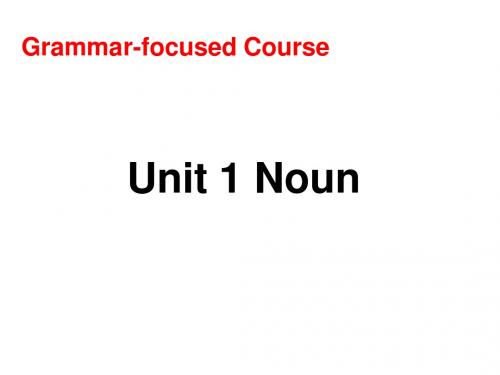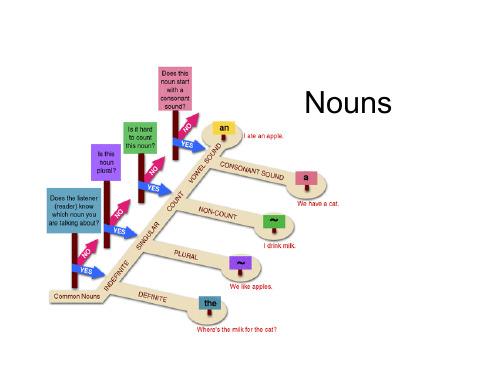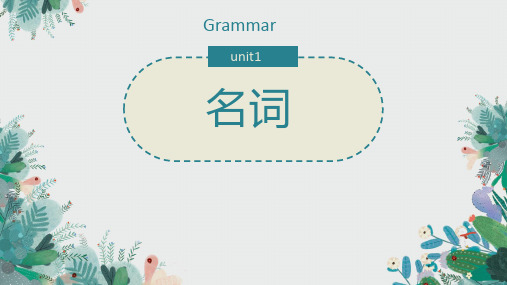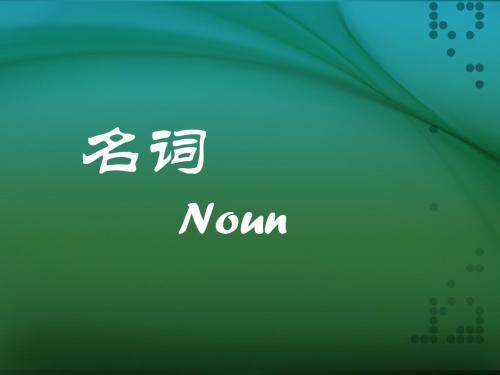一、名词的种类.ppt
合集下载
英语语法基础-PPT

It is too difficult a test for us beginners.
He didn’t kown how great a mistake he had made. C)quite,rather与单数名词连用,冠词位于其后,但若 rather,quite前有形容词修饰,则不定冠词置于前后均可,如:
It was rather a disaster. He is rather an unplearant person.=He is a rather unpleasant person.
❖ 2,定冠词的位置
❖ 通常位于名词或名词修饰语之前,但若遇上 all,both,double,half,twice,three times等词的时候,定冠词置于其中。如:
consider one’s feelings make friends with 与某人交朋友 take measures to do sth 采取措施做某事 make repairs 修理 make matters better使情况好转
第二章冠词
❖ 分类:不定冠词,定冠词,零冠词 ❖ 冠词的位置: ❖ 1、不定冠词的位置A)若遇上such,what,many,half等词,不
❖ If I were her ,I would leave. ❖ 注:单独使用的人称代词通常用宾格。如:
❖ “I want to leave.” “Me too.”
❖ “Who did this?” “Me.” ❖ B)人称代词的排列顺序。对于单数人称代词,其排列通常为“二、三、一”
即you,he and me.而对于复数人称代词,则其排列通常为“一、二、三” 即we,you and they.如:
❖ i)用于某些习语
He didn’t kown how great a mistake he had made. C)quite,rather与单数名词连用,冠词位于其后,但若 rather,quite前有形容词修饰,则不定冠词置于前后均可,如:
It was rather a disaster. He is rather an unplearant person.=He is a rather unpleasant person.
❖ 2,定冠词的位置
❖ 通常位于名词或名词修饰语之前,但若遇上 all,both,double,half,twice,three times等词的时候,定冠词置于其中。如:
consider one’s feelings make friends with 与某人交朋友 take measures to do sth 采取措施做某事 make repairs 修理 make matters better使情况好转
第二章冠词
❖ 分类:不定冠词,定冠词,零冠词 ❖ 冠词的位置: ❖ 1、不定冠词的位置A)若遇上such,what,many,half等词,不
❖ If I were her ,I would leave. ❖ 注:单独使用的人称代词通常用宾格。如:
❖ “I want to leave.” “Me too.”
❖ “Who did this?” “Me.” ❖ B)人称代词的排列顺序。对于单数人称代词,其排列通常为“二、三、一”
即you,he and me.而对于复数人称代词,则其排列通常为“一、二、三” 即we,you and they.如:
❖ i)用于某些习语
名词的分类

baby----babies family---families pony-----ponies小马 city---cities country ---countries
注:以下以f或fe结尾的,直接加 roof---roofs gulf---gulfs 湾 chief---chiefs belief---beliefs proof---proofs safe---safes 保险箱 cliff---cliffs reef –reefs 暗礁 brief –briefs 纲要 注:handkerchief ---handkerchiefs / handkerchieves staff—staffs职员----stafves棒杖 (5) 以辅音字母+O结尾的,多数+es hero negro黑人 tomato potato echo 回声;回响[C][U] buffalo水牛,(北美)野牛 注:以元音字母+O结尾的,以及某些以O结尾的外来词,变成 复数只加S bamboo , zoo, radio , tobacoo , two , studio工作室, Piano, kilo,photo ,kangaroo袋鼠 (6)有的名词有两种复数形式。如:zero — zeros 、zeroes, volcano
(7)有些名词形式上虽是单数,意义上却是复数 cattle 牛(总称) people 人民 police 警察 public 公众 有些名词及一些学科名词形式上是复数,意义上却是单数 news 消息 politics 政治 physics 物理
(8) 可以具体化的抽象名词
surprise, knowledge, success, failure, pleasure, interest, joy, help, honor, exercise; time ,experience ,life 等。 这类名词如果仅仅表示“概念”,是不可数名词, 但如果表示具体的人或事,特别是前面出现形容词修饰时,就成了 可数名词,前面需加冠词。如 He answered in surprise. 他吃惊地回答。(不可数名词) He suddenly appeared on a rainy night, which was a great surprise to us. (令大家吃惊的事情) (可数名词) 。 life is hard . We’re living a happy life under the leadership of the Party .
注:以下以f或fe结尾的,直接加 roof---roofs gulf---gulfs 湾 chief---chiefs belief---beliefs proof---proofs safe---safes 保险箱 cliff---cliffs reef –reefs 暗礁 brief –briefs 纲要 注:handkerchief ---handkerchiefs / handkerchieves staff—staffs职员----stafves棒杖 (5) 以辅音字母+O结尾的,多数+es hero negro黑人 tomato potato echo 回声;回响[C][U] buffalo水牛,(北美)野牛 注:以元音字母+O结尾的,以及某些以O结尾的外来词,变成 复数只加S bamboo , zoo, radio , tobacoo , two , studio工作室, Piano, kilo,photo ,kangaroo袋鼠 (6)有的名词有两种复数形式。如:zero — zeros 、zeroes, volcano
(7)有些名词形式上虽是单数,意义上却是复数 cattle 牛(总称) people 人民 police 警察 public 公众 有些名词及一些学科名词形式上是复数,意义上却是单数 news 消息 politics 政治 physics 物理
(8) 可以具体化的抽象名词
surprise, knowledge, success, failure, pleasure, interest, joy, help, honor, exercise; time ,experience ,life 等。 这类名词如果仅仅表示“概念”,是不可数名词, 但如果表示具体的人或事,特别是前面出现形容词修饰时,就成了 可数名词,前面需加冠词。如 He answered in surprise. 他吃惊地回答。(不可数名词) He suddenly appeared on a rainy night, which was a great surprise to us. (令大家吃惊的事情) (可数名词) 。 life is hard . We’re living a happy life under the leadership of the Party .
英语词性的分类及用法详述 PPT

人称代词的用法:
• I saw her with them, at least, I thought it was her.
•
我看到她和他们在一起,至少我认为是她。(her做宾语,
• them做介词宾语,her作主补)
•
a. -- Who broke the vase?--谁打碎了花瓶?
•
b. -- Me.--我。(me作主语补语= It’s me.)
• I don’t know him well enough.
• There is enough food for everyone to eat. There is food enough for everyone 1) close与closely
• close意思是“近”; closely 意思是“仔细地”
• 形容词作定语修饰名词时,要放在名词的前边。但是如果形容词修饰以-thing为字尾的词语时,要放在这些词之后,例如: • something nice • 以-ly结尾的形容词 • 1)friendly,deadly,lovely,lonely,likely,lively,ugly,brotherly,仍为形容词。 • 2)有些以-ly 结尾既为形容词,也为副词。 • daily,weekly,monthly,yearly,early • The Times is a daily paper. The Times is published daily. • 用形容词表示类别和整体 • 某些形容词加上定冠词可以泛指一类人,与谓语动词的复数连接。如:the dead,the living,the rich,the poor,the blind,the hungry • 多个形容词修饰名词的顺序 • 限定词--数词--描绘词--(大小,长短,形状,新旧,颜色) --出处--材料性质,类别--名词 • a small round table;a tall gray building;a dirty old brown shirt;a famous German medical school
中考英语语法知识专题(1)名词、名词所有格课件(含答案)

—They are very beautiful! You’ve got a wonderful__________.( C )
A. instruction
B. description
C. collection
3.(2016·中考改编)—My favorite TV________is A Bite of China(舌尖上的中国).
物质 名词
抽象 名词
食物 饮料 自然物质 情感 概念 学科,语言
bread,meat,rice,cheese,fish,beef water,tea,coffee,wine,milk,cola wood,sand,soil,air friendship,peace,joy,love news,population maths,physics,geography,English
第三篇 语法知识专题
第一节 名词/名词所有格
名词 (一)名词的分类:名词是表示人或事物名称的词。它分为专有名词和普通名词。
类别
定义
例词
专有名词
表示具体的人名,事物, China,the Great 地名,组织等名称的词。 Wall
可数 普通
名词 不可
数
个体名词 集体名词 物质名词 抽象名词
表个别人或事物的名称 表若干人或事物的名称 表物质或材料的名称 表感情等抽象概念的名称
情况
特殊 名词
构成方法 变内部元音
单复数同形 完全不规则
例词 man—men,woman—women,foot—feet,tooth—
teeth Chinese,Japanese,sheep,deer,fish (中国人和日本人喜爱绵羊、鹿和鱼) penny—pence,child—children,mouse—mice
名词

高三英语学生学习课件
G.单复数相同的词 G.单复数Fra bibliotek同的词sheep aircraft cattle means Swiss 绵羊 飞机 牛 方法 瑞士人 deer fish steelworks Chinese Japanese 鹿 鱼 钢厂 中国人 日本人
H.德国人
father-in–law editor-in-chief
LessonⅡ Ⅱ Card 5
13. There are art ______ (work) of the Tang Dynasty. 14.We need much ______ (room) for all the furniture. 15. We all know that _____ speak louder than words.
LessonⅡ Ⅱ Card 4
10. _____________ (child) shoes are on the second floor of his store department. 11.On the whole, he was a ______ (fail) in his life. 12. Now more and more people prefer to have a _____ at home---- a little dog, a cat or some other animals.
tooth foot mouse goose woman policewoman ox child teeth 牙齿 feet 脚 mice 老鼠 geese 鹅 women 女人 policewomen 女警察 oxen children 牛 小孩
F.词尾加-en或 F.词尾加-en或-ren 词尾加
《名词及所有格》课件

名词作定语的用法
• 名词作定语表示事物的性质或特征,如"flower bed"表示花坛;表示时间或地点,如"day off"表示休息日;表示用途或功 能,如"typewriter table"表示打字桌。
抽象名词的具体化
抽象名词通常表示概念、情感或状态等 抽象概念,如"love"、"happiness"。
不规则变化
常见的名词复数的不规则变化有:“man”变为“men”,“child”变为 “children”,“ox”变为“oxen”等。
还有一些特殊的复数形式,如“knife”的复数为“knives”,“sheep”的复数 为“sheep”等。
特殊情况
01
有些名词的单数和复数形式相同 ,如“deer”、“sheep”、 “Chinese”、“Japanese”等 。
。
宾语可以由名词、代词、数词、 动名词等不同词性担任。
宾语通常出现在句子的末尾,回 答“谁”或“什么”的问题。
表语
表语是用来说明主语的性质、特征、身份等,通常由名词、形容词、副词等担任。
表语位于系动词之后,与主语一起构成复合主谓结构,表示主语的身份或状态。
表语在句子中起到补充说明的作用,使句子意思更加完整和清晰。
抽象名词的具体化是通过比喻、拟人等 修辞手法将抽象概念具体化,如"love
is blind"、"happiness is a warm puppy"。
以上内容仅供参考,具体内容可以根据 实际需求进行修改和调整。
THANKS
感谢观看
以-s结尾的复数名词 只需在末尾加“’” ,而不是“s’”。
2024年高职单招中职英语《名词》精讲课件

(一)名词的数
2.复合名词变复数:
①有man、woman的合成名词,两者都变复数
man doctor→men doctors woman teacher→women teachers ②“名词+名词”的合成名词,则后面的的名词变复数 boy student→boy students girl student→girl students apple tree→apple trees ③把主体名词变复数(名词+修饰语)
(一)名词的数
2.可数名词变复数的不规则变化
man→ men woman→ women tooth→ teeth foot→ feet goose →geese child→ children ox→ oxen mouse→ mice ①变单数名词中的元音字母或其他形式。 fish deer sheep means species series ②单复数同形:
(二)双重所有格的形式: 名词+of+名词的-’s所有格 名词+of+名词性物主代词 名词+of +one’s own
A friend of Tom’s will join us in the game. Some friends of mine often help me with my English. I want a room of my own.
(一)名词的数
Chinese→Chinese Japanese→Japanese Swiss→Swiss Englishman→Englishmen Frenchman→Frenchmen German→Germans German→Germans Italian→Italians ③某国人的复数变化:中日瑞不变,英法变,其他后面加s
英语十大词类之名词

国家、团体、机构等。
名词
(表示人、事 物和抽象概念 的名称的词)
个体名词 集体名词 普通名词
(表示某一类人 或事物)
( 表示可以个别存在的事物。 )
( 表示同一类许多个体的总称。 )
物质名词
( 表示不可以个别存在的物质。 )
抽象名词
( 表示某种抽象概念,如情感、 心理、品质、意志等。 )
① 名词的种类
teacup --- teacups
② 名词的数
2. 以 s, x, ch, sh 结尾的名词,加 “es”:
bus --- buses box --- boxes fox --- foxes tax --- taxes boss --- bosses class --- classes wish --- wishes glass --- glasses dish --- dishes dress --- dresses watch --- watches match --- matches brush --- brushes bench --- benches cockroach– cockroaches (蟑螂)
名 词
普 通 名 词
个体 名词
集体 名词 物质 名词
doctor, teacher, orange, desk, shop, dog, gun, tree, child, foot, man, hat, knife, key, umbrella, handbag
police 警察,people, family, army, staff 职员, crew 水手, livestock 家畜,jewellery 珠宝, team 队, crowd 人群, audience 观众 rice,water,fire,air , paper,ice, milk, oil, iron, salt, sugar, beer, flour, gold, coal, bread, wine, wood, soap, coffee, tea, sand, corn, snow, rubbish, toothpaste, gas fun 玩笑,kindness 善意,youth 青春, health 健康, courage 勇气,beauty 美, peace 和平, power 力量, anger 愤怒, genius天赋, cruelty 残忍, advice 意见, French 法语, information 信息, education 教育
名词
(表示人、事 物和抽象概念 的名称的词)
个体名词 集体名词 普通名词
(表示某一类人 或事物)
( 表示可以个别存在的事物。 )
( 表示同一类许多个体的总称。 )
物质名词
( 表示不可以个别存在的物质。 )
抽象名词
( 表示某种抽象概念,如情感、 心理、品质、意志等。 )
① 名词的种类
teacup --- teacups
② 名词的数
2. 以 s, x, ch, sh 结尾的名词,加 “es”:
bus --- buses box --- boxes fox --- foxes tax --- taxes boss --- bosses class --- classes wish --- wishes glass --- glasses dish --- dishes dress --- dresses watch --- watches match --- matches brush --- brushes bench --- benches cockroach– cockroaches (蟑螂)
名 词
普 通 名 词
个体 名词
集体 名词 物质 名词
doctor, teacher, orange, desk, shop, dog, gun, tree, child, foot, man, hat, knife, key, umbrella, handbag
police 警察,people, family, army, staff 职员, crew 水手, livestock 家畜,jewellery 珠宝, team 队, crowd 人群, audience 观众 rice,water,fire,air , paper,ice, milk, oil, iron, salt, sugar, beer, flour, gold, coal, bread, wine, wood, soap, coffee, tea, sand, corn, snow, rubbish, toothpaste, gas fun 玩笑,kindness 善意,youth 青春, health 健康, courage 勇气,beauty 美, peace 和平, power 力量, anger 愤怒, genius天赋, cruelty 残忍, advice 意见, French 法语, information 信息, education 教育
名词Nouns

4. 抽象名词的复数形式: sympathy [U, C, usually pl.] the feeling of being sorry for sb; showing that you understand and care about sb's problems: ◆ I wish he'd show me a little more sympathy. ◆ (formal) May we offer our deepest sympathies on the death of your wife. [U, C, usually pl.] the act of showing support for or approval of an idea, a cause, an organization, etc: ◆ Her sympathies lie with the anti-abortion lobby.
不可数名词向可数名词转化 P46-47
4. 抽象名词的复数形式 opinion noun 1. [C] ~ (about / of / on sb/sth), ~ (that ...) your feelings or thoughts about sb/sth, rather than a fact: We were invited to give our opinions about how the work should be done. Everyone had a different opinion on the subject.
不可数名词向可数名词转化 P46-47
4. 抽象名词的复数形式 opinion noun 2. [U] the beliefs or views of a group of people: Public opinion is shifting in favour of change.
不可数名词向可数名词转化 P46-47
4. 抽象名词的复数形式 opinion noun 1. [C] ~ (about / of / on sb/sth), ~ (that ...) your feelings or thoughts about sb/sth, rather than a fact: We were invited to give our opinions about how the work should be done. Everyone had a different opinion on the subject.
不可数名词向可数名词转化 P46-47
4. 抽象名词的复数形式 opinion noun 2. [U] the beliefs or views of a group of people: Public opinion is shifting in favour of change.
《初中语文语法大全》(共34张PPT)

句子 种类
结构 分
①动词谓语句:你改悔吧! ②形容词谓语句:我气量大.
单句
主谓句
③名词谓语句:每人一盏灯. ④主谓谓语句:我的讲义,你能抄
八下
下来吗?
21页
①动词非主谓句标志极了. 谓句 ③名词非主谓句:一盏灯!
①因果复句
因果类复句 ②假设复句
九上29页 ③条件复句
句子
句子:
1、概念:由短语或词构成,是具有特定句调,能够表达一 个相对完整的意思的语言单位.
2、标志:
〔1必须具有一个相对独立完整的意思.
〔2必须具有一定的语气和语调,在书面上有一个句末标点.
3.例如:
雷锋是我们时代的杰出代表〔短语
雷锋是我们时代的杰出代表!〔句子
同学们,你们懂不懂这个问题呀?
懂!
〔1北风呼呼叫,大雪纷纷飘. 〔2外面叭叭地响起枪声.
作句子 的成分.
〔3河水哗哗地流着.
〔4咣,门被什么人踢开了. 〔5轰隆隆!外面传来一声炮响.
作句子.
看谁判断有对又快: 连词 形容词
动词
量词
1.左拉有一副朴实但很固执的脸庞.
名词
名词 数词 形容词 副词
助词
副词
介词
2.月色便朦胧在这水汽里.
名词
四、助词;
1、概念:附着在词或短语后,表示某种语法意义.
2、种类:看前面可知有结构助词、情态助词、语气 助词.
3、语法功能:和别的词语共同构成句子成分.
〔1我们民族历史上最〔灿烂的〔科学的春天到来了. 〔2大家都[圆满地]完成了自己的任务. 〔3李老师高兴<得说不出话来>.
结构助词
看下面的例子:
语气助词
名词 名词的定义分类(70张)

tooth--teeth foot--feet
goose--geese
(3)单复数同形 Chinese – Chinese fish – fish
Japanese – Japanese sheep–sheep
口诀巧记: “中日”不变“英法”变
其余s加后面
(4)常以复数形式出现的名词 people clothes shoes trousers socks glasses
【答案】: B 【要点点拨】:
解析:逐个排除法 句意为:虽然很难下决心,但是我还是决定辞职。 B项make a decision表示“下决心;作决定”符合题意。 A项suggestion表示“建议”之意;C项make a plan表示“制定计划”之 意;D项speech表示“演讲”。
3.5 Discover the structure
不以s结尾的复数名词的所有格,仍按惯例加“’s” Children’ s Day men’ s shoes
无生命名词的所有关系用of加名词,构成所属关系的短语 the color of the wall a picture of the classroom
注:stomach/k/ – stomachs
(3)以辅音字母加y结尾的名词,变y为i加“es” * country – countries * baby – babies
* factory – factories * party – parties
请区别:如果是元音字母加y 结尾的名词则只须加“s”
特殊: roof---roofs belief---beliefs proof---proofs
(5) 以o结尾的名词,一般情况加s。 * piano – pianos * zoo – zoos * Radio - radios * bamboo – bamboos
初中英语语法专题课件完整版(共983张PPT)

2.不规则变化
构成方法
例词
形式不变 (单复数同形)
sheep-sheep deer-deer Chinese-Chinese Japanese-Japanese
变内部元音字母
foot-feet tooth-teeth goose-geese man-men mouse-mice
词尾加-en/-ren
a group of 一队,一组,一群
②还可用much,little,a little of,a large amount/deal of, no,plenty of等来修饰不可数名词,some,any既可修饰可数名词也可修 饰不可数名词。
much money,plenty of water a little of air some(肯定句): some milk ,some apples any(疑/否):Are there any stamps?I don’t have any money (5)数词-名词-形容词构成的复合形容词,中间的名词不能用
普通名词又可分为下面四类:
1)个体名词:表示单个人或单个事物。 如:gun、kid 、book。 2)集体名词:表示一群人或一些事物组成的集合体。 如:family。
3)物质名词:表示无法分为个体的物质、材料、食品、饮料、液体、气体、 金属等名称的名词,
如:pork、wood、bread、water、air。 4)抽象名词:表示动作、状态、品质、感情等抽象概念及学科、疾病。 如:work 。Hunger、honesty 、love、Chinese、success、HIV。 个体名词和集体名词可以用数目来计算,称为可数名词。
f,fe 为v,再加 -es
shelf-shelves thief-thieves
英语语法名词课件PPT

boss—bosses box—boxes
brush—brushes class—classes glass—glasses
match—matches watch—watches
⑤以 o 结尾的名词可能加-s,也可能加-es。
加-s:小马虎弹着钢琴 (piano) 听着收音机(radio),又到动 物园 (zoo) 和袋鼠 (kangaroo) 照相 (photo),最后考试得了个 大鸭蛋(零分) (zero)。
初中英语 语法
课件PPT
第一部分 语法知识盘点
第1讲 名词
一、将下列名词归类 noodle, chalk, bread, pie, weather, pen, second, parent, newspaper, water, meat, factory, present, computer, furniture, lemonade, friend, person, advice, promise, gold, English 1.可数名词:__n_o_o_d_le_,_p_i_e,_p_e_n_,_s_e_c_o_n_d_,_p_a_re_n_t_,_n_e_w_s_p_a_p_e_r,__ _f_a_c_to_r_y_,p_r_e_se_n_t_,_c_o_m_p_u_t_e_r,_f_r_ie_n_d_,_p_e_r_so_n_,_p_r_o_m__is_e__________ 2.不可数名词:_c_h_a_lk_,_b_r_e_a_d_, _w_e_a_th_e_r_,_w_a_t_e_r,_m__e_a_t,_f_u_r_n_it_u_re_,_ _l_em__o_n_a_d_e_, _a_d_v_ic_e_,_g_o_l_d_, E__n_g_li_s_h________________________
Noun

不规则名词复数: 2. 不规则名词复数: 英语里有些名词的复数形式是不规则的: 英语里有些名词的复数形式是不规则的: 例词 manwomanman-men, woman-women, 改变名词中的元音 footgoosemousefoot-feet, goose-geese, mouse字母或其他形式 mice cattle 牛deer 鹿Chinese 中国 人fish 鱼species 种类 单复数相同 aircraft 飞机 sheep 羊 只有复数形式 裤子glasses 眼镜scales trousers 裤子glasses 眼镜scales 天平arms 武器thanks 天平arms 武器thanks 感谢 sweepings 清扫物 规则
将主体名词变 为复数 合 无主体名词时 成 将最后一部分 名 变为复数 词 将两部分变为 复数
sons-inlookerssons-in-law, lookers-on, passers- storypassers-by, story-tellers, boy friends grown-ups成人, housewives, grown-ups成人, 成人
以-oo或元音字母加-o结尾的名词只加-s。如: oo或元音字母加- 结尾的名词只加或元音字母加 banboo - bamboos 竹子 kangaroo - kangaroos 袋鼠 video - videos 电视 radio - radios 收音机
名词的复数。(可数名词的规则变化和不规则变化) 。(可数名词的规则变化和不规则变化 二、名词的复数。(可数名词的规则变化和不规则变化)
birdshoplakebird-birds, shop-shops, lake-lakes churchdishclassboxchurch-churches, dish-dishes, class-classes, boxboxes factoryflyfamilybabyfactory-factories, fly-flies, family-families, babybabies tomatoherotomato-tomatoes, hero-heroes leafthiefshelfknifeleaf-leaves, thief-thieves, shelf-shelves, knifelifehalfknives, life-lives, half-halves
- 1、下载文档前请自行甄别文档内容的完整性,平台不提供额外的编辑、内容补充、找答案等附加服务。
- 2、"仅部分预览"的文档,不可在线预览部分如存在完整性等问题,可反馈申请退款(可完整预览的文档不适用该条件!)。
- 3、如文档侵犯您的权益,请联系客服反馈,我们会尽快为您处理(人工客服工作时间:9:00-18:30)。
• b.词尾发生变化:child-children
• c. 单数、复数形式相同:fish-fish, Japanese-Japanese , sheep-sheep , ChineseChinese
(3).物质名词量的表示方法
• a. 用much , a little , a lot of等表示多少 e.g. much water , a little money
s,也要加’s • e.g. the boy’s bag men’s room
• b. 表示几个人共有一样东西,只需在最后 一个人的名字后加’s,如表示各自所有,则 需在各个名字后加’s
• e.g. This is Tom and Jason’s room.这是Tom和 Jason共有的房间。
• These are Tom’s and Jason’s rooms.
• e.g. the windows of the house
• the picture of the family
Exercise
• 1. I visited (Tom’s)house yesterday. • 2. Give me a (piece)paper,please. • 3. Look at those (sheep). • 4.How many (radios)can you see? • 5. That bag is my (father’s).
• 这些是Tom和Jason各自的房间。
• c. 若名词已有复数词尾s,只加’ • e.g. the workers’ rooms • the teachers’ reading room
• (2)名词+of+名词 • 名词是有生命的,我们用’s结构来表示所有
关系。如果是无生命的,我们用名词+of+名 词的结构来表示所有关系。
• b.以s,x,ch,sh,o结尾的加es
• c.以辅音字母加y结尾的单词把y变成i加-es:citycities,country-countries
• 不规则变化的复数形式:
• a.元音发生变化:man-men,foot-feet, woman-women,tooth-teeth,mouse-mice
• b. 用容器表示 • e.g. a bowl of rice, a glass of water , a piece
of paper • 当要表示两杯茶、四张纸这类概念时,在
容器后加复数,如:two cups of water, four pieces of paper
3.名词的所有格
• (1)名词+’s • a. 单数名词词尾加’s,复数名词词尾如没有
一、名词的种类
1.名词的种类
• 专有名词:Beijing,China,Sunday
• 普通名词: 可数名词 个体名词:pen,book
•
集体名词词:milk,rice
•
抽象名词:love,rest
2.名词的数
• (1)单数:a bird,an orange • (2)复数: • 规则变化的复数形式: • a. 一般情况下加-s:girls,pens
